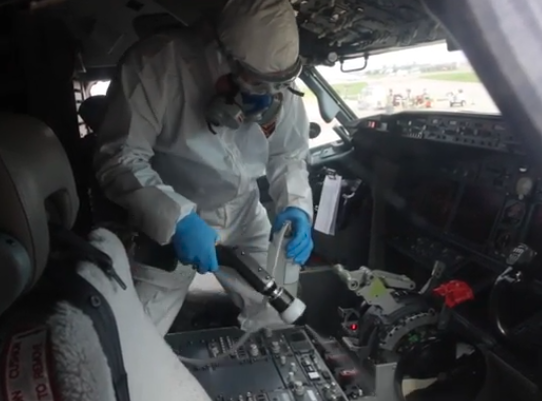A forensic engineering firm is warning that using foggers to disperse disinfectants — a common practice as businesses reopen after COVID-19 closures — may cause permanent damage to electronic equipment.
Atlanta-based Envista Forensics released a paper last week cautioning business owners to turn off all devices and cover them before fogging. If that’s not possible, skip the fogging and apply disinfectants by hand instead, said Mark Ewing, major loss practice leader for Envista in Chicago.
Ewing said studies by the Environmental Protection Agency show that the chemicals most commonly used to spray disinfectants are corrosive and can damage sensitive electronic equipment.
“I think sometimes companies don’t really know how reactive, chemically, those defoggers can be,” Ewing said in a telephone interview. “They are focused more on ‘what can we do to disinfect and kill the coronavirus?'”
Ewing said a chemist for the company alerted team members to the potential problem after spotting an article on FlightGlobal.com, a trade publication for the airline industry. It included photographs of maintenance workers for Royal Jordanian Airlines spraying disinfectants inside aircraft cabins and cockpits.
In the paper written by forensic materials scientist Carlos Garcia, Envista said while some materials such as doorknobs, light bulbs and countertops may be able to withstand exposure to disinfectants, electronic components may not.
In a September 2014 technical brief, the EPA reported that personal computers exposed to chlorine dioxide, methyl bromide and ethylene bromide experienced higher rates of functional failure than a control group that was not exposed. One of the highest failure rates came from a popular COVID-19 fogging disinfectant: chlorine dioxide.
Envista noted that all of the fogging agents contain water.
“A drop of mineralized water on an unprotected electronic circuit board will cause corrosion and lead to electrical failures,” the Envista report says. “Some circuit boards, depending on their design specifications, are protected with a conformal coating. Therefore, some boards will suffer little to no degradation from exposure to corrosive disinfectants, while others will exhibit significant deterioration.”
Envista said it believes that repeated fogging of electronic equipment will cause material degradation and functional failures.
“It’s a great tool in the toolbox, but not the only one,” said Envista Marketing Manager Amanda Emery. “It should only be used for certain materials, and in a certain way, to even be successful. The last thing business owners want to go through right now after all of this is having to submit a claim for deteriorated equipment — extending the business interruption they’ve already faced.”
Delta Airlines, Southwest Airlines and United Airlines each promoted their use electrostatic sprayers to apply disinfectants to decontaminate aircraft. The devices add a charge to particles that makes the disinfectant cling to surfaces.
Southwest Airlines on April 22 posted a video on its website showing a maintenance worker using a hand sprayer to apply disinfectant in an aircraft cabin and directly onto uncovered instruments in the cockpit. The airline said the electrostatic technology is different that the “foggers” that work by saturating the atmosphere with droplets that slowly settle on surfaces.
“It puts out a very fine mist that has a wraparound effect around objects that are hard to reach so it is very effective in applying in a very consistent and effective manner,” said Brian Bond, director of aircraft appearance, says on the video.
Southwest Airlines said it as ordered 100 of the electrostatic sprayers and will put them to use as the airline resumes normal operations.
The airline did not respond to a request for comment.
About the photo: Shown is a screen shot of a Southwest Airlines promotional video about its decontamination procedures.
Was this article valuable?
Here are more articles you may enjoy.


 Forecast Calls for Wildfires to Burn More Land Across U.S. This Year
Forecast Calls for Wildfires to Burn More Land Across U.S. This Year  Uber Sued by FTC Over ‘Deceptive’ Subscription Sign-Ups
Uber Sued by FTC Over ‘Deceptive’ Subscription Sign-Ups  Survey Shows Distracted Drivers Overconfident: 20% Text While Driving, 15% Use Social Media
Survey Shows Distracted Drivers Overconfident: 20% Text While Driving, 15% Use Social Media  Uber Spends Six Figures on Ads in Latest NY Insurance Reform Push
Uber Spends Six Figures on Ads in Latest NY Insurance Reform Push 